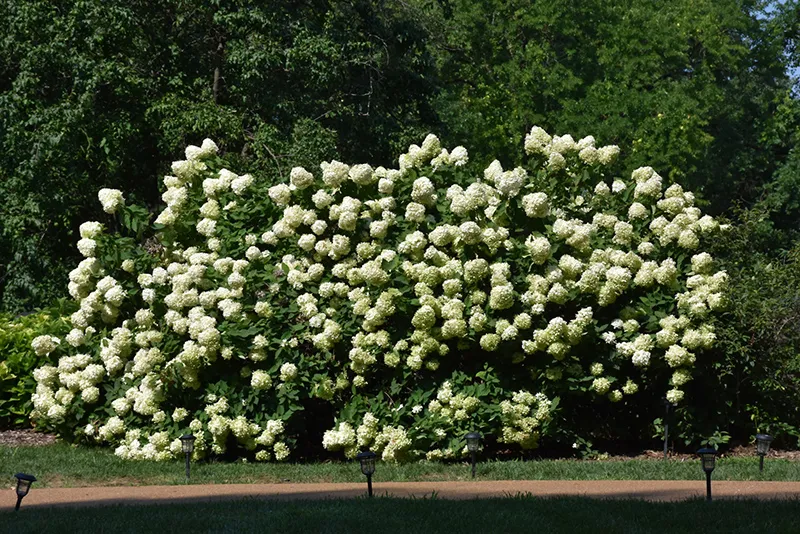Family: Hydrangea
Type: Shrub

Limelight Hydrangea (Hydrangea paniculata ‘Limelight’) is a standout deciduous shrub, famous for its large, lime-green flowers that bloom from mid-summer to fall. This variety showcases a unique color transition, with flowers turning from green to pink, red, and burgundy as the seasons change.
Limelight Hydrangea is a hardy plant that can grow up to 6-8 feet tall and wide, making it a prominent feature in any garden. Its ability to thrive in a range of soil types, its drought tolerance once established, and minimal care requirements make it a favorite among gardeners looking for reliable and dramatic blooms.
Hardiness Zone: 3b-8b
Pet Friendly: Yes
Moisture Preference: Average to moist
Sun Needs: Full sun to shade
Growth Rate: Medium
Average Height (feet): 8
Average Spread (feet): 8
Average Life Span (years): 40
Form: Upright spreading
Flower Color: Green
Secondary Flower Color: White
Bloom Season: From mid summer to late fall
Foliage Color: Green
Foliage Shape: Pointy
Bark Color: Gray
Bark Texture: Smooth
Incorporating Limelight Hydrangea into your garden design can create a breathtaking display of color and texture. It’s perfect for use as a specimen plant, in mass plantings, or as a hedge to provide privacy or define boundaries.
The stunning lime-green to pink flowers add a splash of color to the landscape, drawing the eye and enhancing the overall aesthetic of your garden. Pairing Limelight Hydrangea with perennials and shrubs that have contrasting foliage or bloom colors can create a dynamic and visually appealing garden space. Its robust size and showy flowers also make it an excellent choice for creating a focal point in mixed borders.

Limelight Hydrangea fits beautifully into the relaxed, informal setting of a cottage garden, adding height and a touch of whimsy with its large, colorful blooms.
In formal garden designs, Limelight Hydrangea can be used to create structured hedges or as a standalone specimen, offering elegance and a burst of color.
This hydrangea variety also adapts well to woodland garden settings, where its bright blooms can lighten up shaded areas under a canopy of trees.
Use Limelight Hydrangea to line driveways or pathways, creating an inviting and dramatic entrance to your home. It’s also ideal for planting in large containers on patios or terraces, where its magnificent blooms can be admired up close. For an impactful autumn display, combine Limelight Hydrangea with fall-blooming perennials and grasses, enhancing the beauty of your garden as the seasons change.
Select our pre-made garden layouts to create a landscape that’s uniquely yours. Simple, smart, and customizable!
In spring, Limelight Hydrangea begins to show new growth, with fresh, green foliage emerging, setting the stage for the spectacular blooms to follow.
Summer is when Limelight truly shines, with its distinctive lime-green flowers transforming outdoor spaces into vibrant, lively gardens.
As fall arrives, the flowers of Limelight Hydrangea transition to shades of pink, red, and burgundy, providing stunning late-season color.
During winter, the bare branches of Limelight Hydrangea add structural interest to the garden, especially when dusted with snow, and hint at the promise of spring to come.
Perovskia atriplicifolia
Salvia 'May Night'
Miscanthus sinensis Gracillimus
Limelight Hydrangea performs best in locations that receive full sun to partial shade, with a preference for morning sunlight and afternoon shade in hotter climates.
It requires at least 4 hours of direct sunlight daily but appreciates some shade during the hottest part of the day to protect its blooms.
This hydrangea prefers well-drained, moist soil that is rich in organic matter. It can tolerate a range of soil pH but flourishes in slightly acidic to neutral soil.
Space Limelight Hydrangea plants 6 to 8 feet apart to accommodate their mature size and promote healthy air circulation.
The best time to plant is in early spring or fall, allowing the plant to establish itself during moderate weather conditions.
Dig a hole as deep as the root ball and twice as wide. Place the plant in the hole, backfill with soil, water thoroughly, and apply a layer of mulch.
Regular watering is crucial, especially during dry periods. Aim to keep the soil consistently moist but not waterlogged.
Apply a slow-release, balanced fertilizer in early spring to support healthy growth and abundant blooms.
Prune in late winter or early spring, removing only dead wood and spent flowers to encourage new growth.
Apply mulch to retain moisture and fertilize as new growth appears. Prune as needed to shape the plant.
Keep the soil moist, especially in hot weather. Provide extra water during extreme heat.
Reduce watering as the plant begins to go dormant. Apply a fresh layer of mulch for winter protection.
No specific care is needed in winter. Assess the plant's health in early spring and prune accordingly.
Hydrangea paniculata 'Limelight (tree form)'
Hydrangea paniculata 'Jane'
Hydrangea arborescens 'Annabelle'
While it can tolerate partial shade, Limelight Hydrangea needs some direct sunlight to bloom profusely. Full shade may reduce flowering.
Limelight Hydrangea can reach 6 to 8 feet in both height and width when mature, depending on growing conditions and pruning.
Unlike some hydrangeas, the flower color of Limelight Hydrangea is not affected by soil pH. Its blooms transition from lime-green to pink and burgundy regardless of the soil’s acidity or alkalinity.
Sign up below to get exclusive deals, discounts, and new plant collections—delivered straight to your inbox! Plus, stay inspired with the latest gardening tips, landscaping trends, and DIY garden ideas. Start growing with us today!
A big thank you for subscribing to the PBN Design newsletter.
We're thrilled to have you join our community. Get ready for exciting updates, insightful content, and more delivered straight to your inbox.
Stay tuned!
Go backA big thank you for subscribing to the PBN Design newsletter.
We're thrilled to have you join our community. Get ready for exciting updates, insightful content, and more delivered straight to your inbox.
Stay tuned!
Go back